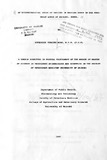| dc.description.abstract | Inability to achieve self-sufficiency in food production,
especially protein, in Kenya has necessitated the need to improve
agricultural productivity. As a result, poultry production is being
used to meet this food requirements although its potential has not
been fully exploited due to various constraints such as poor
husbandry and disease control.
This study was done with the main objective of ascertaining
whether as.-c-ites condition is a problem in broiler industries in the
peri-urban areas of Nairobi. In this study, prevalence of ascites
and potential risk factors associated with its occurrence were
examined. The economic impact of ascites in broiler production was
also assessed.
The area of study covered the peri-urban districts of Nairobi,
namely Machakos, Kajiado and Kiambu districts, which were further
categorized according to agro-ecological zones ECZII, EZCIII and
EZCIV. Data was gathered from 57 Kenchic Contract farms located in
the study area and visited between January and March 1995.
Considered also, was a sub-sample of 49 Kenchic Contract farms
which were actively followed to slaughter at the kenchic abattoir
located at Tigoni in Kiambu District, from January to April 1995.
other data were obtained from kenchic abattoir records for 1992,
1993 and 1994. These data were computerised and analysed.
The farm survey achieved 100% response rate. Ascites was
reported singly or in combination with other diseases in 47% of the
farms in ECZII, 50% of the farms in ECZIII and 62% of the farms in
ECZIV. Overall, the leading causes of broiler poultry condemnations
at Tigoni abattoir from January to April 1995 were cadavers (51.5%),
ascites (26.1%) and others (22.4%). However, from the 1992 to 1994
abattoir data, ascites was the major cause of broiler poultry
condemnations in the three ecological zones.
xv
There existed significant (P=0.0071) annual variations in mean
ascites prevalences in 1992, 1993 and 1994, with the lowest (0.52%)
annual prevalence in 1994. However there was no significant
(P=0.5351) variations in zone-specific mean ascites prevalence. Risk
factors associated with prevalence of ascites from this study were
age at slaughter, mortality during rearing, month of placing day old
chicks, total feed consumed by a broiler during rearing period,
brooding time, presence of other diseases, temperature range and
inadequate ventilation.
There was evidence of substantial monetary loss attributed to
ascites. For instance in 1994, the total market loss was estimated
at Ksh 1,677,100.00, while that for the three month study period in
1995 was estimated at Ksh 120,494.67.
From this study, it could be concluded that the prevalence of
broiler ascites in Kenya is low and that it is not associated with
altitude as in temperate countries. Also changes in farm management
aspects and company policies such as feeding regime and age at
slaughter have effect on ascites prevalence. The results demonstrate
that ascites is a major problem in commercial broiler production at
farm and abattoir level especially when monetary losses and
opportunity costs are considered. | en |

